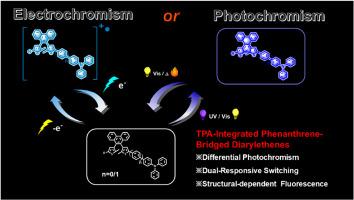基于π桥工程的双响应分子体系:可见光光致变色、电荧光致变色和差分发射开关
IF 4.2
3区 工程技术
Q2 CHEMISTRY, APPLIED
引用次数: 0
摘要
智能刺激响应材料因其在推进下一代技术方面的关键作用而受到广泛关注。光学和电刺激由于其高灵敏度和快速反应动力学而特别有价值。在本研究中,我们通过π共轭工程开发了一种创新的多刺激响应分子体系。该系统结合了电活性三苯胺(TPA)和光活性菲基序,采用直接连接和苯环桥接策略。系统的研究表明,π共轭扩展在光化学和电化学性能中起着决定性的作用:苯桥化衍生物能够实现可见光驱动的光致变色(400-410 nm活化),克服了传统的依赖于紫外线的活化的局限性;直接连接的TPA -菲共轭物通过TPA+•自由基的形成和双向荧光调制表现出快速的电致变色。值得注意的是,工程二芳烯在单个分子支架内表现出协同光致变色-电致变色耦合,正如电致变色装置的成功制造所证明的那样。这种集成的光和电响应性为自适应多功能智能材料的开发提供了一种新的分子工程策略。本文章由计算机程序翻译,如有差异,请以英文原文为准。

Dual-responsive molecular systems via π-bridge engineering: Visible-light photochromism, electrofluorochromism and differential emission switching
Smart stimuli-responsive materials have attracted considerable attention due to their crucial role in advancing next-generation technologies. Optical and electrical stimuli are particularly valuable owing to their high sensitivity and rapid response kinetics. In this study, we develop an innovative multi-stimuli-responsive molecular system through π-conjugation engineering. This system integrates electroactive triphenylamine (TPA) and photoactive phenanthrene motifs using both direct linkage and benzene-ring-bridged strategies. Systematic investigations reveal that π-conjugation extension plays a decisive role in governing the photochemical and electrochemical properties: Benzene-bridged derivatives enable visible-light-driven photochromism (activation at 400–410 nm), overcoming the limitations associated with conventional UV-dependent activation; directly linked TPA–phenanthrene conjugates exhibit rapid electrochromism through the formation of TPA+• radicals, and bidirectional fluorescence modulation. Notably, the engineered diarylethenes demonstrate synergistic photochromic–electrochromic coupling within a single molecular scaffold, as evidenced by the successful fabrication of an electrochromic device. This integrated optical and electrical responsiveness provides a novel molecular engineering strategy for the development of adaptive, multifunctional smart materials.
求助全文
通过发布文献求助,成功后即可免费获取论文全文。
去求助
来源期刊

Dyes and Pigments
工程技术-材料科学:纺织
CiteScore
8.20
自引率
13.30%
发文量
933
审稿时长
33 days
期刊介绍:
Dyes and Pigments covers the scientific and technical aspects of the chemistry and physics of dyes, pigments and their intermediates. Emphasis is placed on the properties of the colouring matters themselves rather than on their applications or the system in which they may be applied.
Thus the journal accepts research and review papers on the synthesis of dyes, pigments and intermediates, their physical or chemical properties, e.g. spectroscopic, surface, solution or solid state characteristics, the physical aspects of their preparation, e.g. precipitation, nucleation and growth, crystal formation, liquid crystalline characteristics, their photochemical, ecological or biological properties and the relationship between colour and chemical constitution. However, papers are considered which deal with the more fundamental aspects of colourant application and of the interactions of colourants with substrates or media.
The journal will interest a wide variety of workers in a range of disciplines whose work involves dyes, pigments and their intermediates, and provides a platform for investigators with common interests but diverse fields of activity such as cosmetics, reprographics, dye and pigment synthesis, medical research, polymers, etc.
 求助内容:
求助内容: 应助结果提醒方式:
应助结果提醒方式:


